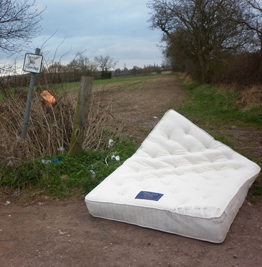Councils dealt with 711,000 incidents of fly-tipping in 2012/13 in England, ranging in size from single black bag to significant multiple lorry loads. Over 30 per cent were small van load size and nearly 45 per cent were on highways (pictured; a roadside fly tip in south Derbyshire). There was a 4 per cent decrease in fly-tipping incidents in England in 2012/13 compared to 2011/12 with downward trends in all incident size categories. Fly-tipping incidents in England have been decreasing in the six years for which data is available and are now 44 per cent lower than in 2007/08.
These facts are from the Defra (Department for the Environment) statistics on flytipping – click here.
About two-thirds, 67 per cent of fly-tips in England in 2012/13 involved household waste. That compares with 6pc commercial waste. About half of flytipping happens on roads. Fewer cases of tipping were on council land, but the Government reports 10 per cent increases in numbers of incidents of fly tipping in footpaths, bridleways and back alleyways in England. Together these now account for 212,000 cases, or one in five – 20 per cent – of fly-tipping incidents.
The estimated cost to councils in England in 2012/13 of clearing fly-tipping was £36.4m, nearly 3 per cent reduction over 2011/12.
Legal definition
Fly-tipping is the illegal deposit of waste on land contrary to the Environmental Protection Act 1990.
The Environment Agency investigates and enforces against the larger, more serious and organised illegal waste crimes. The 2012/13 Environment Agency data is available on the gov.uk website (https://www.gov.uk/government/statistical-data- sets/env24-fly-tipping-incidents-and-actions-taken-in-england). Both Local Authorities and the Environment Agency are required to collect data on their activity and report this to the Flycapture database. Responsibility for dealing with fly-tipping on private land rests with private landowners and is not subject to mandatory data reporting.
The downward trend in fly-tipping incidents could reflect a number of possible factors, according to the Environment Agency. Councils may have put more effort into enforcement and/or raising awareness of fly-tipping issues. The Environment Agency has worked with authorities to improve reporting quality and has produced guidance to reduce the possibility of double counting in authority returns. This can occur for example when an incident is recorded at the point a Local Authority is notified and also by a waste management contractor who clears up the fly-tip.
A breakdown of data for each council is available on the Defra website. In assessing the figures Local Authorities should not be classified as ‘good’ or ‘poor’ performers based purely on numbers of fly-tips. The position is complex and population density, housing stock and commuter routes can all have an impact. Those reporting higher incident numbers are often those taking the issue seriously and being rigorous in identifying incidents. Large authorities may have large enforcement teams using modern, sophisticated methods (covert surveillance, the Smartwater marking product) to catch professional fly-tippers.










